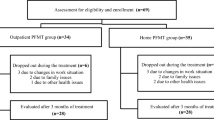Abstract
Introduction and hypothesis
Pelvic floor muscle training (PFMT) is considered to be the first-line treatment for female stress urinary incontinence (SUI). There are few studies that have tested the efficacy of unsupervised PFMT. The aim of this study was to compare the effectiveness of intensive supervised PFMT to unsupervised PFMT in the treatment of female SUI.
Methods
Sixty-two women with SUI were randomized to either supervised or unsupervised PFMT after undergoing supervised training sessions. They were evaluated before and after the treatment with the Oxford grading system, pad test, quality of life questionnaire, subjective evaluation, and exercise compliance.
Results
After treatment, there were no differences between the two groups regarding PFM strength (p = 0.20), International Consultation on Incontinence Questionnaire-Short Form score (p = 0.76), pad test (p = 0.78), weekly exercise compliance (p = 0.079), and subjective evaluation of urinary loss (p = 0.145).
Conclusions
Both intensive supervised PFMT and unsupervised PFMT are effective to treat female SUI if training session is provided.


Similar content being viewed by others
References
Abrams P, Cardozo L, Fall M, Griffiths D, Rosier P, Ulmsten U et al (2002) Standardization Sub-committee of the International Continence Society. The standardization of terminology of lower urinary tract function: report from the Standardization Sub-committee of the International Continence Society. Neurourol Urodyn 21:167–178
Ortiz C (2004) Urinary stress incontinence in the gynecological practice. Int J Gynaecol Obstet 86(Suppl 1):S6–S16
Fantl JA, Bump RC, Robinson D, McClish DK, Wyman JF (1996) Efficacy of estrogen supplementation in the treatment of urinary incontinence: the Continence Program for Women Research Group. Obstet Gynecol 88:745–749
Guarisi T, Pinto-Neto AM, Osis MJ, Pedro AO, Costa-Paiva LH, Simões F (2001) A procura de serviço médico por mulheres com incontinência urinária. RBGO 23:439–443
Hannestad YS, Rortveit G, Sandvik H, Hunskaar S, Epidemiology of Incontinence in the County of Nord-Trøndelag (2000) A community-based epidemiological survey of female urinary incontinence: the Norwegian EPINCONT study. Epidemiology of Incontinence in the County of Nord-Trøndelag. J Clin Epidemiol 53:1150–1157
Hay-Smith E, Bø K, Berghmans L, Hendriks H, deBie R, van Waalwijk et al (2007) Pelvic floor muscle training for urinary incontinence in women. Cochrane Database Syst Rev CD 001407
Freeman RM (2004) The role of pelvic floor muscle training in urinary incontinence. Br J Obstet Gynaecol 111:37–40
Castro RA, Arruda RM, Zanetti MR, Santos PD, Sartori MG, Girão MJ (2008) Single-blind, randomized, controlled trial of pelvic floor muscle training, electrical stimulation, vaginal cones, and no active treatment in the management of stress urinary incontinence. Clinics 63:465–472
Bø K (2004) Pelvic floor muscle training is effective in treatment of female stress urinary incontinence, but how does it work? Int Urogynecol J 15:76–84
Bø K, Talseth T, Holme I (1999) Single blind, randomized controlled trial of pelvic floor exercises, electrical stimulation, vaginal cones and no treatment in management of genuine stress incontinence in women. Br Med J 318:487–493
Alewijnse D, Mesters I, Metsemakers J, Adriaans J, van den Borne B (2001) Predictors of intention to adhere to physiotherapy among women with urinary incontinence. Health Educ Res 16:173–186
Alewijnse D, Mesters I, Metsemakers J, van den Borne B (2003) Predictors of long-term adherence to pelvic floor muscle exercise therapy among women with urinary incontinence. Health Educ Res 18:511–524
Bø K, Hagen RH, Kvarstein B, Jørgensen J, Larsen S (1990) Pelvic floor muscle exercise for the treatment of female urinary stress incontinence: III. Effects of two different degrees of pelvic floor muscle exercises. Neurourol Urodyn 9:489–502
Konstantinidou E, Apostolidis A, Kondelidis N, Tsimtsiou Z, Hatzichristou D, Ioannides E (2007) Short-term efficacy of group pelvic floor training under intensive supervision versus unsupervised home training for female urinary stress incontinence: a randomized pilot study. Neurourol Urodyn 26:486–491
Wilson PD, Al Samarrai T, Deakin M, Kolbe E, Brown AD (1987) An objective assessment of physiotherapy for female genuine stress incontinence. Br J Obstet Gynaecol 94:575–582
Wong KS, Fung BKY, Fung LCW, Ma S (1997) Pelvic floor exercises in the treatment of urinary stress incontinence in Hong Kong Chinese women. In: Abstracts from the 27th Annual Meeting of the International Continence Society. Yokohama, pp 62–63
Ramsay IN, Thou MA (1990) A randomized double blind placebo controlled trial of pelvic floor exercises in the treatment of genuine stress incontinence. Neurourol Urodyn 9:398–399
Bump RC, Mattiasson A, Bø K, Brubaker LP, DeLancey JO, Klarskov P (1996) The standardization of terminology of female pelvic organ prolapse and pelvic floor dysfunction. Am J Obstet Gynecol 175:10–17
Laycock J, Whelan MM, Dumoulin C (2008) Patient assessment. In: Haslam J, Laycock J (eds) Therapeutic management of incontinence and pelvic pain, 2nd edn. Springer, London, p 62
Tamanini JT, Dambros M, D’Ancona CA, Palma PC, Rodrigues-Netto N Jr (2005) Responsiveness to the Portuguese version of the International Consultation on Incontinence Questionnaire - Short Form (ICIQ-SF) after urinary stress incontinence surgery. Int Braz J Urol 31:482–489
Kegal AH (1951) Physiologic therapy for urinary stress incontinence. JAMA 146:915–918
Thompson JA, O’Sullivan PB, Briffa NK, Neumann P (2006) Assessment of voluntary pelvic floor muscle contraction in continent and incontinent women using transperineal ultrasound, manual muscle testing and vaginal squeeze pressure measurements. Int Urogynecol J 17:624–630
Morin M, Dumoulin C, Bourbonnais D, Gravel D, Lemieux MC (2004) Pelvic floor maximal strength using vaginal digital assessment compared to dynamometric measurements. Neurourol Urodyn 23:336–341
Saleme CS, Rocha DN, Del Vechio S, Pinotti M (2009) Mechanical simulator for the levator ani. Revista Brasileira de Engenharia Biomédica 25:123–130
Conflicts of interest
None
Author information
Authors and Affiliations
Corresponding author
Rights and permissions
About this article
Cite this article
Felicíssimo, M.F., Carneiro, M.M., Saleme, C.S. et al. Intensive supervised versus unsupervised pelvic floor muscle training for the treatment of stress urinary incontinence: a randomized comparative trial. Int Urogynecol J 21, 835–840 (2010). https://doi.org/10.1007/s00192-010-1125-1
Received:
Accepted:
Published:
Issue Date:
DOI: https://doi.org/10.1007/s00192-010-1125-1




